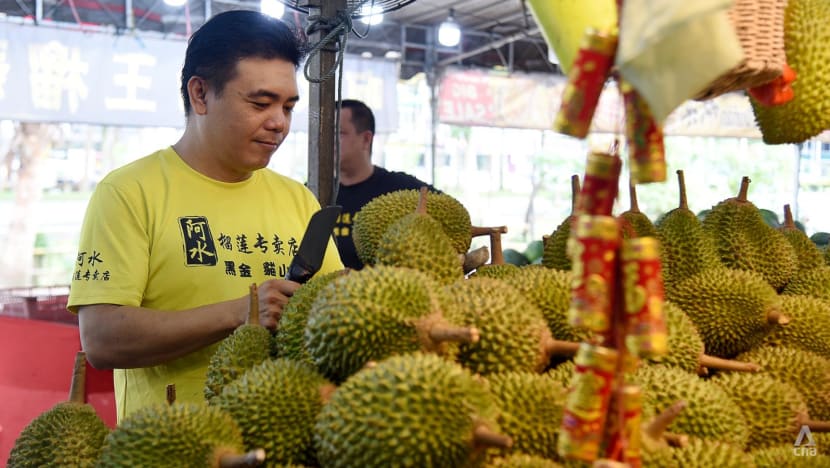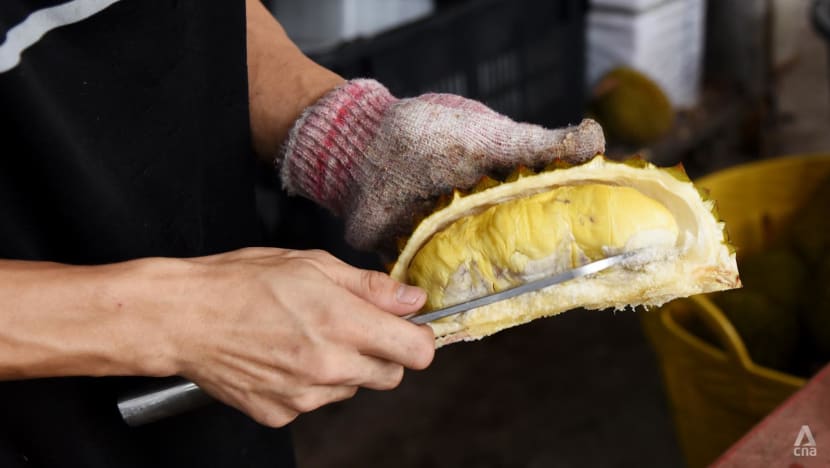Durian supply down by 20% due to rainy weather, but prices stable for now
It could be a little harder to get one’s hands on the king of fruits this season.

FILE: Mr Teoh Sock Soon, owner of Ah Shui Durian, inspects durian fruit before selling it to customers in Johor Bahru on May 14, 2024. (Photo: CNA/Zamzahuri Abas)

This audio is generated by an AI tool.
SINGAPORE: The durian season may be back, but it could be a little harder to get one’s hands on the king of fruits this season.
Supply has dropped by about 20 per cent due to the wet weather. On the bright side, however, prices have stayed stable from last year.
Durian sellers across Singapore told CNA that there will be no shortage of the thorny fruit, despite China's plans to import fresh durians from Malaysia.
MUSANG KING TOPS LIST FOR DURIAN LOVERS
The peak durian season in Malaysia typically lasts from May until August.
But Malaysian durian exporters have observed a delay in this year's durian harvest, with many attributing this to the unpredictable weather. They shared their concerns that uncertain weather conditions can affect the quantity and quality of the fruit.
The owner of 227 Katong Durian store, who only wanted to be known as Ah Loon, said there are weeks when sellers get a high supply of durians.
“Then out of a sudden, like today, (there is) 60 per cent less in supply,” he added. “(It goes) high and low, high and low for this year.”
When CNA visited several durian stores along Geylang Road, they were all bustling with activity.
Sellers there said they sell around 100 baskets of durians on average every day. While the number is still less compared to last year, they are still satisfied with sales so far.
This year, the Musang King has continued topping the list for durian lovers.
The price for a kilogram of this durian variety ranges from S$23 to S$38 (US$17 to US$28), which is about the same as last year.
“The Musang King is actually more flavourful. Everybody loves the bitterness and sweetness of the durian,” said Mr Charlie Phua, business development director at supplier Durian Supply.
Customers are also spending more on other varieties such as Red Prawn, Black Thorn and Golden Phoenix.
“During durian season, there’s more people eating, because every kind of durian is nice,” said Mr Kang Tian Pao, a sales assistant at Wonderful Durian.
“If it’s not in season, no one wants to eat.”

LOGISTICAL ISSUES OF EXPORTING DURIANS TO CHINA
There could be more good news for durian fans: Sellers told CNA that prices could fall from August because of more harvests.
They assured customers that even with recently-announced plans for Malaysia to export fresh durians to China, the world’s largest consumer market for the fruit, they do not have to worry about a shortage.
The Chinese market also prefers more exotic varieties of durians like the Black Thorn, over traditionally popular types such as the Musang King, they added.
“One of the reasons why we will still import to Singapore is because on the logistical side, the issue of just having our trucks bring our durians from Malaysia to Singapore is so much easier,” said Mr Phua.
“Everything is easier compared to China itself.”
He added that durian suppliers are trying to solve the logistical issues of exporting to China, as it takes about one-and-a-half days to reach the country.
“These fruits have about two to three days of (shelf life),” he explained.
“So when we reach the retail stage, retailers may only have half a day to sell the durians before they go bad.”

















